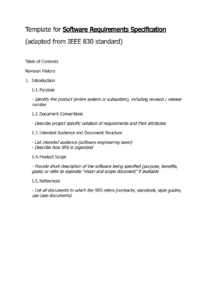When developing a new database or updating an existing one, gathering detailed requirements is paramount. By using a database requirements gathering template, you can systematically capture all the necessary information to ensure the database meets its intended purpose while avoiding costly mistakes.
An effective database requirements gathering template provides a structured approach to collect both functional and non-functional requirements. Functional requirements define the specific tasks and processes the database must support, while non-functional requirements outline qualities such as performance, availability, and security.
Step-by-Step Guide to Using a Database Requirements Gathering Template
To use a database requirements gathering template effectively, follow these steps:
1. Identify Stakeholders: Begin by identifying all individuals who have a vested interest in the database, including end-users, managers, and IT staff. Their perspectives will provide a comprehensive understanding of the requirements.
2. Collect Information: Conduct interviews, hold workshops, and review documentation to gather data on current and future database needs. Use the template to capture detailed information about entities, attributes, relationships, constraints, and business rules.
3. Organize and Analyze: Group similar requirements together and analyze their dependencies. This helps identify any conflicting or overlapping requirements that need to be resolved.
4. priorize Requirements: Evaluate the importance and urgency of each requirement and prioritize them accordingly. This ensures that critical requirements are met first.
5. Document and Communicate: Clearly document the gathered requirements using the template and share it with all stakeholders. This fosters a shared understanding and minimizes misinterpretations.
Advantages of Using a Database Requirements Gathering Template
Using a database requirements gathering template offers several advantages:
1. Structured Approach: It provides a systematic framework for gathering requirements, ensuring a comprehensive and consistent approach.
2. Improved Communication: The standardized format facilitates better communication between stakeholders, reducing confusion and misunderstandings.
3. Error Reduction: The template ensures that all necessary information is collected, which helps mitigate errors and omissions.
4. Time Saving: By following a structured process, teams can save time and effort during the requirements gathering phase.
5. Base for Database Design: The gathered requirements serve as the foundation for designing and implementing the database, ensuring it aligns with business needs.
Conclusion
A well-structured database requirements gathering template is an invaluable tool for capturing and managing the requirements of a successful database project. By following a systematic approach, organizations can ensure that their databases meet their intended objectives, avoid disruptions, and support business growth.
Investing time in using a database requirements gathering template not only simplifies the initial stages of database development but also lays the groundwork for a reliable and efficient system that meets the evolving needs of the organization.


